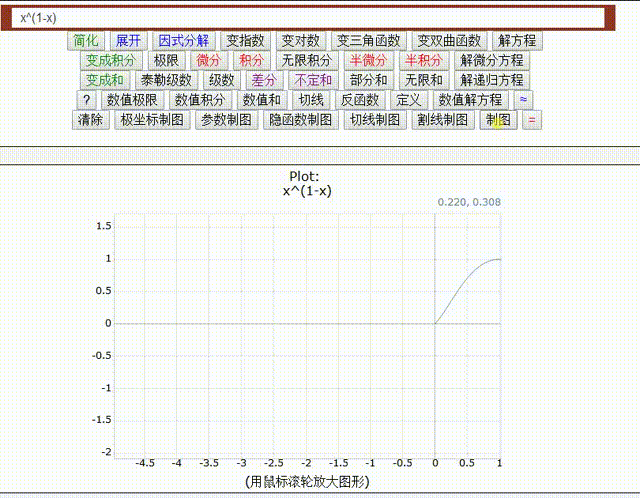 +
+  +
+  +
+  =
= 
 +
+  +
+  +
+  =
= 
For completeness the branches of all of these functions will be visualized individually. Here are links to each function:
asin
acos
atan
acot
asec
acsc
asinh
acosh
atanh
acoth
asech
acsch
pow
log
W
W is inverse of exp(x)*x
The presentation is split into two pages to facilitate initial rendering.
The exponential exp(x) is an entire function, meaning it has no finite singularities. Its linear combinations in the circular and hyperbolic trigonometric functions likewise have no finite singularities and can be visualized, like the exponential, with a single complex branch. The inverse functions differ because they can be expressed in terms of the logarithm, the inverse of the exponential, which has an infinite number of complex branches. The inverse trigonometric functions inherit this behavior from the logarithm.
The complex logarithm log(x) acquires an extra phase of 2πi in moving from branch to branch. Its value on an arbitrary branch can be expressed as
where n is a signed integer labeling the branch. All of the inverse trigonometric functions can be written as expressions quadratic in the exponential function. After solving for this and taking an inverse, the behavior of the logarithm identified here can be applied to them directly, taking into account any multiplicative factors that arise.
Inverse circular and hyperbolic functions are related in pairwise fashion by rotation and interchange of real and imaginary parts, except for cosines and secants. This can be seen by depicting their principal branches side-by-side for comparison, with hyperbolic functions on the right:
Consider first the hyperbolic tangent in terms of the exponential. Solving for this gives
Applying the behavior of the logarithm, the inverse hyperbolic tangent on an arbitrary branch is
The individual branches look like this:
The real part of this function retains the same numerical value between branches, while the imaginary part moves up and down in value. Visualize the imaginary part of several branches simultaneously:
This graphic illustrates a feature of the logarithm that will apply to all of the functions considered here: its coloration by argument quickly becomes monochromatic on branches with an index of higher absolute value.
The gaps between adjacent branches here and in subsequent visualizations of multiple branches represent the removal of artifacts arising from the parametric representations employed. They could be removed using the healing method of this presentation, but will be left as is for simplicity of rendering. The analytic functions naturally continue across all such gaps.
The circular tangent differs from the hyperbolic tangent in having imaginary units in the exponential, plus an extra factor from the sine. Solving for the exponential gives
Applying the behavior of the logarithm, the inverse circular tangent on an arbitrary branch is
The individual branches look like this:
The imaginary part of this function retains the same numerical value between branches, while the real part moves up and down in value. Visualize the real part of several branches simultaneously:
The hyperbolic cotangent differs from the tangent merely in the sign of the exponential. Solving for this gives
Applying the behavior of the logarithm, the inverse hyperbolic cotangent on an arbitrary branch is
The individual branches look like this:
The real part of this function retains the same numerical value between branches, while the imaginary part moves up and down in value. Visualize the imaginary part of several branches simultaneously:
The circular cotangent differs from the hyperbolic cotangent in having imaginary units in the exponential, plus an extra factor from the sine. Solving for the exponential gives
Applying the behavior of the logarithm, the inverse circular cotangent on an arbitrary branch is
The individual branches look like this:
The imaginary part of this function retains the same numerical value between branches, while the real part moves up and down in value. Visualize the real part of several branches simultaneously:
Now consider the hyperbolic sine in terms of the exponential. Solving for this gives
The sign from the square root is a new twist that will apply here and in subsequent functions. This branching behavior exists in addition to that of the logarithm and must be included for a full picture of the complex structure. This will be made clear in the visualizations.
Applying the behavior of the logarithm, the inverse hyperbolic sine on an arbitrary branch is
The individual branches look like this:
One half of each branch comes from using the plus sign on the square root, the other half from the minus sign. The lines where clearly discordant colors meet are where transitions to higher or lower branches occur.
The real part of this function retains the same numerical value between branches, while the imaginary part moves up and down in value. Visualize the imaginary part of several branches simultaneously:
The circular sine differs from the hyperbolic sine in having imaginary units in the exponential, plus an extra factor. Solving for the exponential gives
Applying the behavior of the logarithm, the inverse circular sine on an arbitrary branch is
The individual branches look like this:
The imaginary part of this function retains the same numerical value between branches, while the real part moves up and down in value. Visualize the real part of several branches simultaneously:
The hyperbolic cosine differs from the sine merely in the sign of the exponential. Solving for this gives
Applying the behavior of the logarithm, the inverse hyperbolic cosine on an arbitrary branch is
The individual branches look like this:
One half of each branch again comes from using the plus sign on the square root, the other half from the minus sign. The lines where clearly discordant colors meet are again where transitions to higher or lower branches occur.
The real part of this function retains the same numerical value between branches, while the imaginary part moves up and down in value. Visualize the imaginary part of several branches simultaneously:
The circular cosine differs from the hyperbolic cosine in having imaginary units in the exponential. Solving for this gives
Applying the behavior of the logarithm, the inverse circular cosine on an arbitrary branch is
The individual branches look like this:
The imaginary part of this function retains the same numerical value between branches, while the real part moves up and down in value. Visualize the real part of several branches simultaneously:
The hyperbolic secant is the algebraic inverse of the hyperbolic cosine. Solving for the exponential gives
Applying the behavior of the logarithm, the inverse hyperbolic secant on an arbitrary branch is
The individual branches look like this:
The real part of this function retains the same numerical value between branches, while the imaginary part moves up and down in value. Visualize the imaginary part of several branches simultaneously:
The circular secant differs from the hyperbolic secant in having imaginary units in the exponential. Solving for this gives
Applying the behavior of the logarithm, the inverse circular secant on an arbitrary branch is
The individual branches look like this:
The imaginary part of this function retains the same numerical value between branches, while the real part moves up and down in value. Visualize the real part of several branches simultaneously:
The hyperbolic cosecant is the algebraic inverse of the hyperbolic sine. Solving for the exponential gives
Applying the behavior of the logarithm, the inverse hyperbolic cosecant on an arbitrary branch is
The individual branches look like this:
The real part of this function retains the same numerical value between branches, while the imaginary part moves up and down in value. Visualize the imaginary part of several branches simultaneously:
The circular cosecant differs from the hyperbolic cosecant in having imaginary units in the exponential, plus an extra factor. Solving for the exponential gives
Applying the behavior of the logarithm, the inverse circular cosecant on an arbitrary branch is
The individual branches look like this:
The imaginary part of this function retains the same numerical value between branches, while the real part moves up and down in value. Visualize the real part of several branches simultaneously:
And that completes the inventory of individual functions.